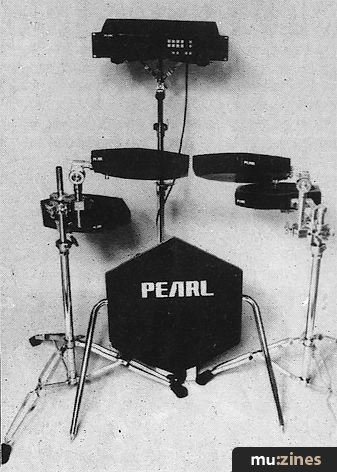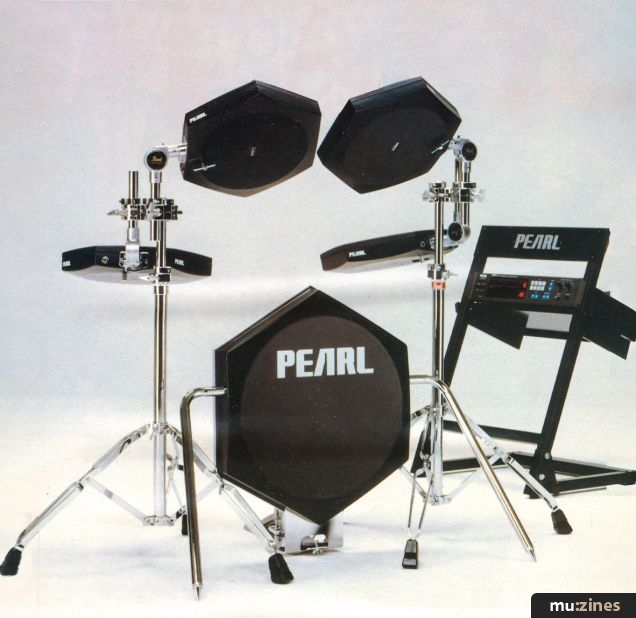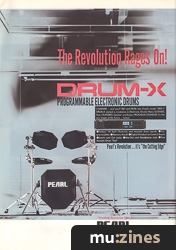Magazine Archive
Home -> Magazines -> Issues -> Articles in this issue -> View
Pearl DRX1 Electronic Drums | |
Article from Electronics & Music Maker, April 1985 | |
Another acoustic drum manufacturer gives tradition the thumbs down and goes electronic. Paul White takes an in-depth look at Pearl's first futuristic percussion offering.
There's no sign of any decline in the market for acoustic drums, but some of the traditionalist manufacturers aren't taking any chances. Pearl are the latest such company to enter the electronic fray.

If this year's Frankfurt Musik Messe was anything to go by, the music world has well and truly woken up to the fact that electronic drums are big business. Wandering aimlessly among the exhibits, it seemed to me as if every other company had some sort of electronic kit on display, and these ranged from the visually exotic to the sonically excruciating. Some were even both at once. Out of this veritable avalanche of new hardware came the Pearl DRX1, seemingly the sensible man's electronic drum system. It sounded good, it was neatly packaged, and it had obviously been designed with the particular needs of drummers in mind.
So, once our Teutonic sojourn was at an end, I lost no time in getting hold of a Pearl kit (the first in the UK, no less) for review. And I'm glad to say that, in the main, those favourable impressions have been reinforced by hands-on experience, and that it offers a combination of facilities you won't find on any other kit in its price range.
Features
The DRX1 is an entirely analogue kit, but it offers a choice of eight user-programmable kit sounds, which puts it one up from other models that offer only factory presets plus one user sound per drum.
The design of the pads themselves owes a lot to the original Simmons concept (in looks, especially), but their construction is more of a novelty, as each drum is based round a rigid plastic moulding fitted with a circular, resilient rubber playing surface. Pearl T900W stands are supplied as standard with the DRX1, and these lock firmly into the pads to give the kit as a whole a very solid, secure feel.
The bass drum is free-standing and supported by a couple of pretty fearsome-looking spurs, and the pedal attaches to the unit by means of a substantial metal plate.
The heart of the Pearl system, as it is with any electronic drum set-up, is the sound-generating module. Pearl have put their sound circuitry inside a 2U-high, 19" rack-mountable case, which seems as good a housing as any I can think of. The unit's front panel incorporates controls for pad sensitivity and sound editing, while the rear panel contains separate outputs for each of the five drum channels, stereo and mono outputs, and a Memory Protect switch. This last-mentioned is usefully equipped with three positions, one that makes the memory totally secure, a second that makes it totally available, and a third that makes only one location available. Additionally, the inclusion of two small six-pin connectors enables the system to be triggered externally, and provision is also made for the connection of a remote program change footswitch, though this isn't yet available and nobody at Pearl Music could shed any light on the subject of what form this will eventually take.
Controls
Considering the amount of control over sound-generating parameters the Pearl system offers, the module's front panel is remarkably uncluttered. The five sensitivity preset stubs are flanked on the right by the main display, which shows all eight variable parameters as well as the number of the program currently in use. An LED lights above the parameter being modified at any one time during editing, and a further indicator shows which of the drums is being affected by the current editing procedure.
The parameters that actually make up a drum sound are Pitch, Bend, Oscillator/Noise balance, Overtone, Attack, Filter Cutoff Frequency, Decay, and overall Level. Each of these is variable in 20 discreet steps, and I imagine most will be familiar to keen followers of all things electro-percussive. As far as I know, however, the Overtone section is unique to the DRX1: for the uninitiated, it's a form of modulation that affects the basic pitch and whose purpose in life is no more sinister than to help recreate a more natural drum sound.
If you want to set up your own sound, the procedure you have to follow is both simple and logical. First, you wish to edit using the number keys. Then you use the increment/decrement pads to select which pad you want to work on, and once you've arrived at this point, the parameter to be modified is located by a pair of similar pads, and the LED status display acts as a constant reminder of what you're doing and where, should you be of a forgetful nature. Parameter values themselves are set by (yes, you've guessed it) another pair of up/down buttons, and the current value is displayed by a two-digit LED readout.
"Considering the amount of control over sound-generating parameters the Pearl system offers, the module's front panel is remarkably uncluttered."
In fact, the entire process is so simple that it becomes second nature within a maximum of five minutes, which is probably just as well, as the DRX1 handbook was still in Japan when I reviewed the kit.
Oh, I nearly forgot. The front panel also incorporates a headphone outlet with its own level control for silent practice - though when was the last time you met a drummer that didn't want to be heard? - and, strangely, Line Input level control through which an auxiliary stereo signal can be mixed with the drum sounds.
Sound & Feel
Surprisingly - because they don't really look all that impressive - the resilient rubber heads felt more like real drum heads than those of any other electronic kit I can think of. The pads' velocity-sensitivity means they exhibit a wide dynamic range during performance, and like real drums, they proved more responsive near their centre. I was really impressed by the attention that had obviously been lavished on this area of design. It's a factor that's vital to the success of electronic kits in the eyes of traditional drummers, yet so many designers choose to give it a lot less thought than it deserves. So full marks to Pearl - who should know what they're talking about, after all - on this one.
Despite the fact that the factory-set sounds are among the most nausea-provoking sonic events I've yet had occasion to witness, it doesn't take much to coax some better-defined, 'classic' electronic drum sounds out of the DRX1. When you think about it, the ingredients which make up an acceptable electronic percussion sound have changed little since Simmons pioneered the field, and what that means in musical terms is that rival companies have had plenty of time to perfect their imitations, sure in the knowledge that the sounds will still be fashionable when the design is in a marketable state.
To Pearl's credit, however, the addition of the Overtone parameter means you can create some pretty decent conga and bongo impersonations in addition to 'conventional' electronic sounds and outlandish (read 'unusable') synth drum effects.
Another point worth making is that stick noise remains at a low level with the Pearl design, so these drums could be used for quiet cabaret or ambient gigs - as well as silent practice, of course - without sounding like a Crompton steam-driven carpet loom.
Conclusions
Pearl are already established as a leading manufacturer of acoustic drum kits, and I see no reason why their first venture into the electronic arena shouldn't earn them a similar reputation. The DRX1 should be available in April, and at an RRP of £1020 inclusive of all HM Government's taxes, it'll be an attractive proposition for anybody seeking programmability in an electronic kit.
And in addition to that programmability, the Pearl kit has the plus points of excellent feel and dynamics, and nothing that I could honestly single out as being bad. There are a couple of omissions, and personally I'd have liked more memory locations for user patches and some sort of master volume control. But as we all know, it's a human trait to want more than you've got, isn't it?
Further information on the DRX1 can be had from Pearl Music, (Contact Details).
Also featuring gear in this article
Captive-Eight - Pearl DRX-1 Electronic Drums
(ES May 85)
Pearl DRX-1
(12T Apr 85)
Pearl DRX-1 Electronic Kit - Drumcheck
(IM May 85)
Browse category: Drums (Electronic) > Pearl
Publisher: Electronics & Music Maker - Music Maker Publications (UK), Future Publishing.
The current copyright owner/s of this content may differ from the originally published copyright notice.
More details on copyright ownership...
Gear in this article:
Review by Paul White
Help Support The Things You Love
mu:zines is the result of thousands of hours of effort, and will require many thousands more going forward to reach our goals of getting all this content online.
If you value this resource, you can support this project - it really helps!
Donations for April 2024
Issues donated this month: 0
New issues that have been donated or scanned for us this month.
Funds donated this month: £7.00
All donations and support are gratefully appreciated - thank you.
Magazines Needed - Can You Help?
Do you have any of these magazine issues?
If so, and you can donate, lend or scan them to help complete our archive, please get in touch via the Contribute page - thanks!








